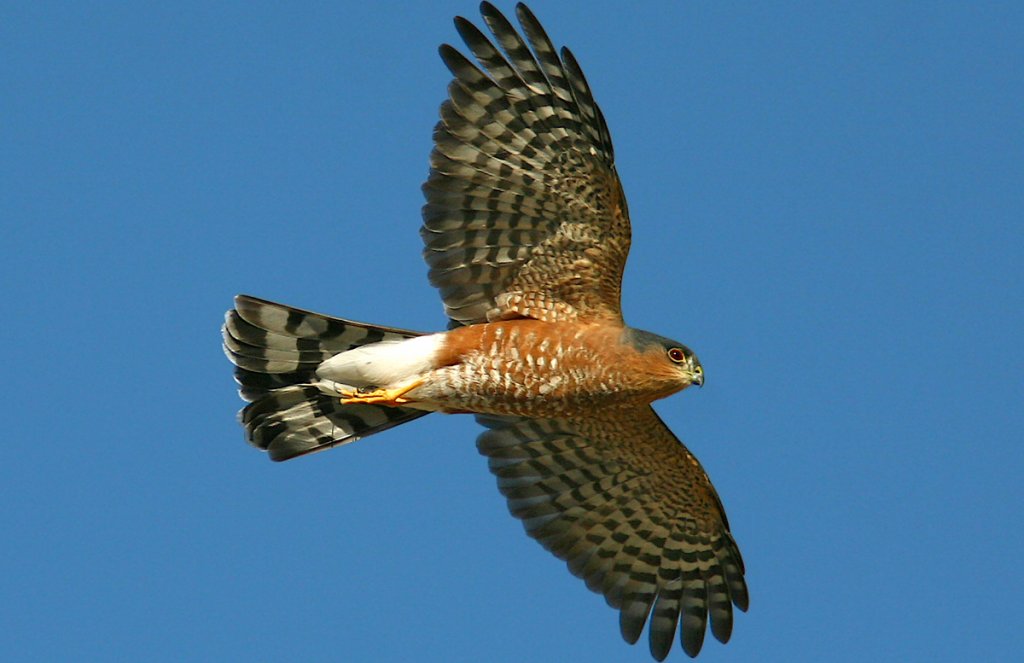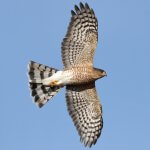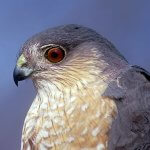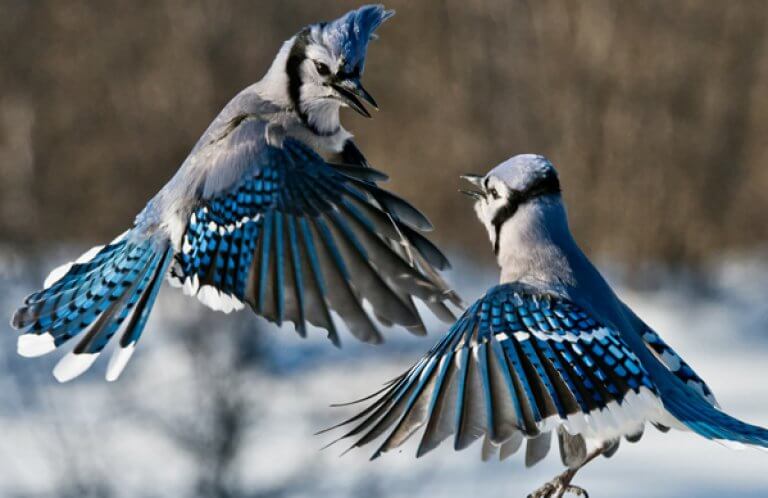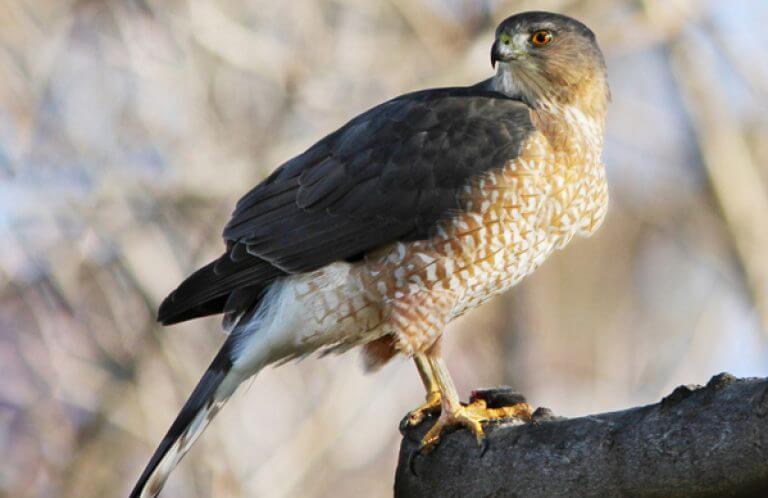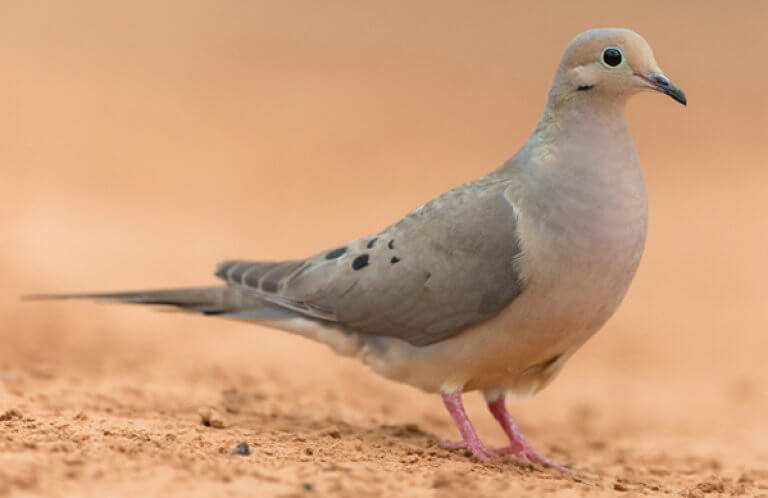About the Sharp-shinned Hawk
The Sharp-shinned Hawk is a small, secretive accipiter (forest hawk), with common names ranging from “Sharpie,” and “Little Blue Darter,” to “Bird Hawk,” the latter a reference to its main source of prey. This is the most sexually dimorphic of all North American raptors, with the smaller male only little larger than a Blue Jay, while the larger female is closer to the size of Common Grackle.
An adult Sharp-shinned Hawk is barred rufous below with gray-blue upperparts and a blackish head and nape. Its eye color ranges from orange to a vivid dark red in older birds. Juveniles look very different from adults, brown above with a light colored, brown-streaked underside and yellow eyes. This bird's characteristic shape — short, rounded wings and long tail – is an excellent adaptation for hunting birds through thick forest understory.
The Sharp-shinned Hawk looks almost identical to another North American accipiter species, the Cooper's Hawk, and telling the difference between the two can be a challenge.
Identification Frustration
Telling a Sharp-shinned Hawk from a Cooper's Hawk can be a real ID challenge for birdwatchers, especially since both species are so elusive, seldom pausing long enough for close observation.
Seen perched, the Sharp-shinned Hawk is the smaller of the two, with a rounded, proportionally smaller head that makes its eyes look extra-large. By contrast, a Cooper's Hawk has a rather blocky-looking, squarish head. An adult Sharpie's dark head and nape form a continuous swath of color, while an adult Cooper's dark head is offset by a paler nape, making this species look as if it's wearing a cap. The Sharp-shinned Hawk's relatively shorter tail is square-tipped when folded, compared to the Cooper's more rounded tail. The Sharp-shinned Hawk has thin, delicate-looking legs, while a Cooper's legs are thicker and sturdier-looking.
In flight, a Sharpie's “wrists” are slightly pushed forward, and its small head barely extends past the leading edge of its wings, whereas a soaring Cooper's wings form a straight leading edge, and more of its larger head is visible. The dainty Sharpie is often buffeted about by gusts of wind as it flies, while the larger Cooper's is able to remain steadier in turbulent air.
Songs and Sounds
The Sharp-shinned Hawk is most often heard giving a sharp “kik, kik, kik” alarm call; it is most vocal during its breeding season.
Listen to a pair of Sharp-shinned Hawks vocalizing here:
Breeding and Feeding
Scrappy Nest Defenders
Sharp-shinned Hawks nest within the tree canopy in dense vegetation, so are difficult to observe while breeding. These scrappy little raptors are fiercely territorial and ably defend their nest from intruders.
Once mated, a Sharp-shinned pair gathers nesting material (usually twigs) and the female builds the nest, lining the structure with bark chips. Nest sites may be reused each year – a pair will refurbish an old nest or build a new nest atop the old one. The female lays 4-5 eggs, which she incubates for around one month. The male brings food to his mate while she is on the nest. After hatching, the female broods her young, especially at night, until near fledging, after about three and a half to four weeks. Parents continue to care for the fledglings for almost a month after they leave the nest.
Bane of Backyard Feeders
The Sharp-shinned Hawk specializes in hunting small songbirds, which make up the majority of its diet. It will tackle birds up to the size of a Mourning Dove or Northern Bobwhite, and also feeds on small mammals, frogs, lizards, and large insects.

This small accipiter is an opportunistic predator, haunting bird feeders and other places its prey congregate, and snatching young birds from nests during the breeding season. It hunts by waiting inconspicuously on a hidden perch, then darting out to seize prey in a short burst of high-speed flight. It may also sneak up on prey during low-level flight. Its long legs and sharp talons allow it to reach into thick vegetation to nab prey, even mid-flight.
Region and Range
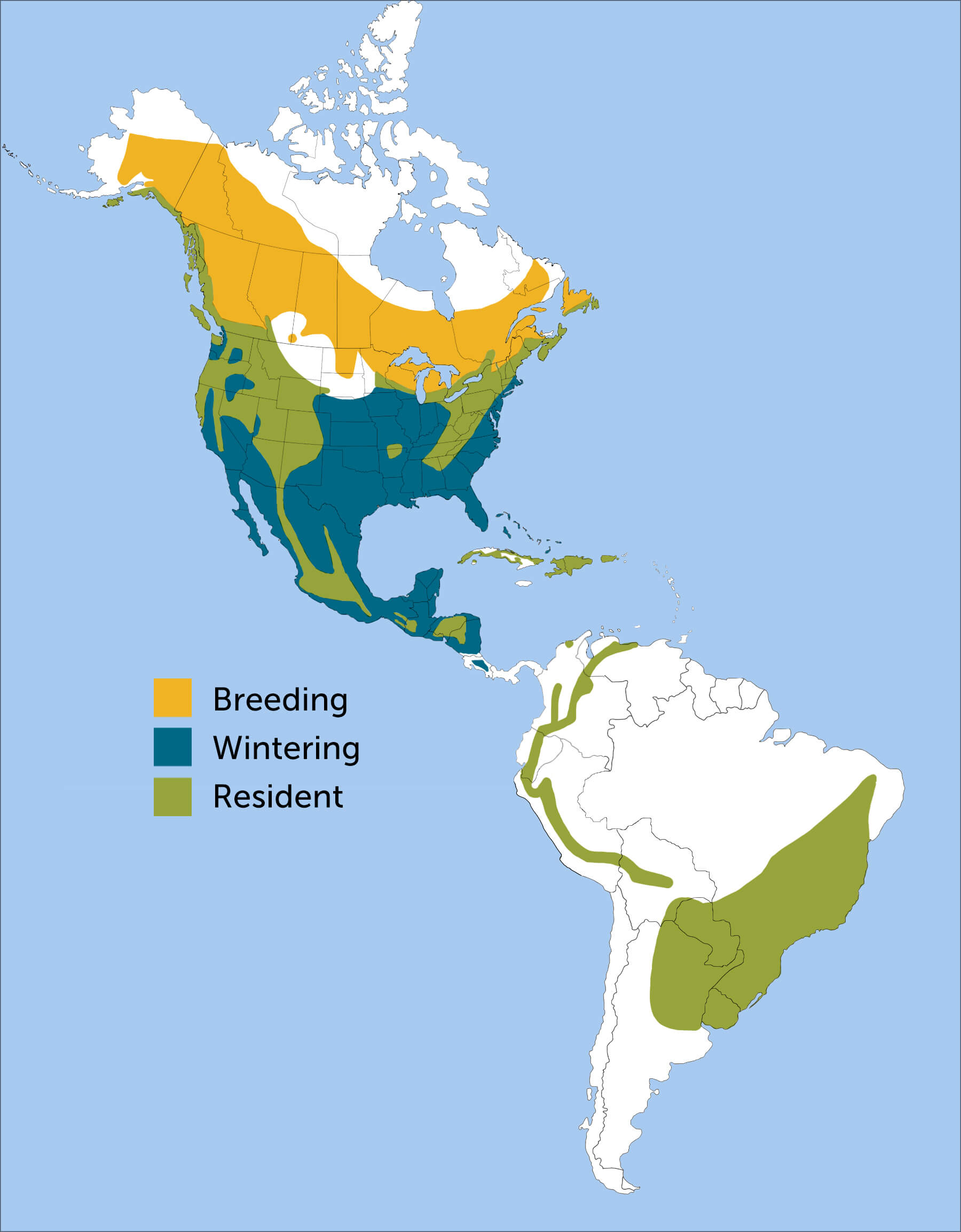
Widespread throughout North America, the Sharp-shinned Hawk may be found in wide variety of forest types from sea level to near alpine areas, as well as near rural, suburban and agricultural areas, where they often stalk bird feeders.
The Sharp-shinned Hawk also occurs in the Caribbean, Central America, and in South America, with a complex taxonomy to match. Ten subspecies are recognized, divided into three main subspecies groups: the Sharp-shinned Hawk (striatus group), White-breasted Hawk (chionogaster group), and Rufous-thighed Hawk (erythronemius group). Three species in the latter two groups (the Rufous-thighed Hawk, White-breasted Hawk, and Plain-breasted Hawk, all found in Central and South America) are sometimes recognized as separate species. One Caribbean subspecies, the Puerto Rican Sharp-shinned Hawk, is listed as Endangered under the Endangered Species Act.
The northernmost (striatus) group of Sharp-shinned Hawk is highly migratory, and the populations breeding in southern South America also may be migratory.
Conservation
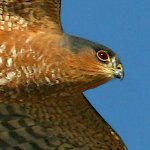
Help support ABC's conservation mission!
Although the Sharp-shinned Hawk declined in the mid-20th century because of human persecution and the use of DDT, the species has largely recovered. Unfortunately, Sharp-shinned Hawks are still frequently victims of deadly collisions with glass and motor vehicles. Some populations may be vulnerable to continued pesticide use as well.
ABC's Pesticides program continues working to block or restrict dangerous pesticides, and we provide a number of online resources to help reduce glass collisions and fatalities, particularly at home windows.
Get Involved
Policies enacted by the U.S. Congress and federal agencies, such as the U.S. Fish and Wildlife Service, have a huge impact on migratory birds. You can help shape these rules for the better by telling lawmakers to prioritize birds, bird habitat, and bird-friendly measures. To get started, visit ABC's Action Center.
Living a bird-friendly life can have an immediate impact on migratory birds in the United States. Doing so can be as easy as adding native plants to your garden, avoiding pesticides, and keeping cats indoors. To learn more, visit our Bird-Friendly Life page.
American Bird Conservancy and our Migratory Bird Joint Venture partners have improved conservation management on more than 8.5 million acres of U.S. bird habitat — an area larger than the state of Maryland — over the last ten years. That's not all: With the help of international partners, we've established a network of more than 100 areas of priority bird habitat across the Americas, helping to ensure that birds' needs are met during all stages of their lifecycles. These are monumental undertakings, requiring the support of many, and you can help by making a gift today.





































